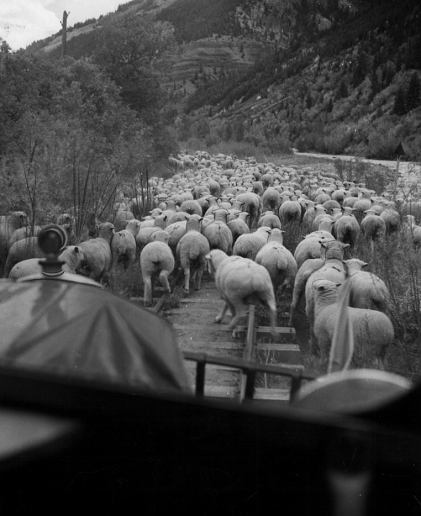The Galloping Geese of the Colorado Rockies
Posted on 11 July 2015
By the 1930's the Rio Grand Southern Railway was struggling to stay afloat. Up to that point it had supplied small towns in Colorado's Rocky Mountains using narrow gauge steam locomotives. These were expensive to operate when they weren't running at capacity, and because the majority of what they hauled was mail, a few passengers, and small goods for merchants, the steam trains were largely overkill. This was particularly compounded by the fact that a locomotive, even a small narrow gauge model, is quite heavy and wears hard on the rails and roadbeds.

The company’s solution was to devise and use a rail “motor” instead: a standard, road-going automobile modified with narrow gauge locomotive wheels. The first motor the RGSR built was a 1931 Buick sedan with the rear half of its passenger compartment removed and replaced with a flat bed. Shortly after its debut, the cargo area was covered and outfitted with seating for passengers. Most of the auto's running gear was preserved, with the chassis modified to accept the narrow gauge locomotive wheels. The motors were colloquially referred to as Galloping Geese, either due to their side-to-side bucking as they waddled down the track, or their honking horns. Goose No.1 (the flattened Buick) had the shortest life, serving for just two years, but in that time it proved to the RGSR that the rail motors were a huge cost savings. Apparently the No.1 had paid for itself within three weeks of operation.

The next six Geese were constructed in varying levels of engineering eccentricity, each individually built by the mechanics at the Railroad's shed in Ridgeway, CO, utilizing used cars and found parts. Goose No.2 was Buick-based like No.1, but the rest were built on Pierce Arrow sedans (Pierce Arrow being a long-defunct American luxury car maker). Throughout their careers the Geese were modified with bodies from Wayne school buses for added passenger space and equipped with WWII surplus GM engines to replace the tired Pierce Arrow units. Numerous other changes happened along the line. Some had their fenders removed and headlights swapped around. By the time the Geese made their last official run in 1951 they were each unique, a mishmash of school bus, 1920's automobile, surplus military parts, and locomotive. Although other rail lines around the world had used automotive based motors, the Galloping Geese were some of the most mechanically unique and visually odd. The last RGSR train to run the line was a steam locomotive that pulled up the tracks as it went with assistance from the Geese, removing the railway altogether.

Amazingly all of the Geese have survived, with the exception of No.1, which was scrapped early on. A few of them continued working for other railway companies, mostly as scrappers, their bus bodies temporarily replaced with flat beds for hauling junk around rail yards. By 1960 even the scrappers had been parked. As the decades passed the Geese were found in scrap or rail yards and saved by museums, theme parks, or industrious citizens. Almost all of our most important and innovative locomotives of the first half of the century have all but disappeared, having been melted down for scrap years ago, yet all but one of the Galloping Geese are still with us. The Geese that are still in service are used occasionally for tourism on small railways around Colorado, having become somewhat famous in railroader circles. No. 3 is the only Goose to have left Colorado, now owned and operated by Knotts Berry Farm in lieu of their larger trains during the off season. It's nice to think about their current keepers, cursing over 80 years of backyard engineering to keep them wobbling down the tracks, perhaps adding their own modifications to keep them rolling on into the future.
